Grafting is one of the most useful techniques for developing bonsai from rough stock. A pine I have been working on for the past few years needs a few more branches before I can reduce it to its final height. To do this, I need to graft into the trunk.
Grafting requires a bit of homework for success. I highly recommend grafting with someone experienced or reading about it before getting started. Although I’ve been doing it for years, I still have a lot to learn. For pine, I’ve found that the end of winter is a good time to graft. I like grafting when it’s really cold out. On warmer days, sap can fill the cuts before the scion makes contact with the tree’s cambium layer. This year I repotted the day before grafting to further slow the flow of sap. Although this goes against common wisdom on the topic, I wanted to give it a try to see what happens.
For scions, I use branches that are one to two years old. Vigorous, but not too vigorous. I avoid using summer growth – the buds that grew after decandling the previous year. And typically, I used less vigorous shoots than the one below whenever possible, but these strong and compact shoots work too.

Scion – a shoot that developed last spring
The first step in preparing the scion is removing extra needles with scissors. 8-10 pairs of needles are usually enough to keep the scion alive. I’ll leave extras if the needles are short, like below, or fewer if the needles are long.
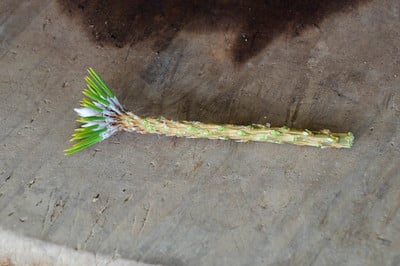
Scion after removing extra needles – 8-10 pairs are usually enough
Next comes the cutting. This is where studying a drawing of cambium layers comes in handy. Knowing where the cambium layer is helps when inserting the scion.
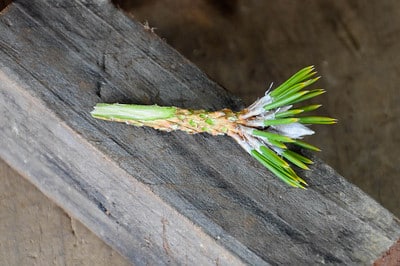
Scion – ready to graft
Here’s another view from the side to show the angles of the cut. Note that the top cut is a bit curved – that’s no good. Straight cuts fit snugly into the incision – curves can leave gaps that fill with sap and prevent the cambium layers from meeting. This can be fixed with another cut.
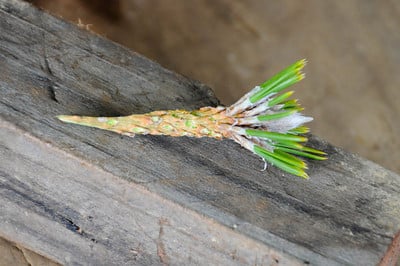
Scion – side view
After cutting the scion, I place it in my mouth to keep it humid. I’m careful not to touch the cut surface. I don’t know how much of a difference this makes, but it’s a comforting habit.
The faster the rest of the process goes the better as delays provide time for sap to flow. I use a 1/2″ chisel to make a vertical incision almost one inch long and maybe 1/4″ deep. This prevents the trunk from tearing when making the main incision. This can be done with a number of chisels, though the best come from Japan and are made specifically for the purpose. I try to use chisels that are the same width as the scion.
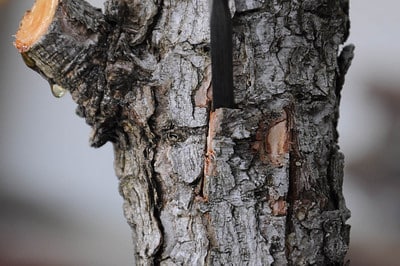
Making the incision
I make the cut fairly deep as it has to match the size of the cut on the scion. Here’s a view from the side.
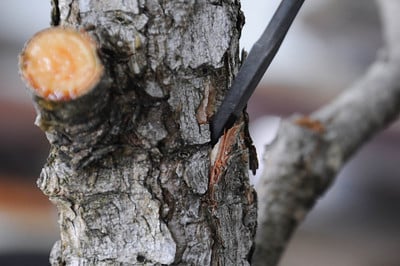
Making the incision – side view
Next I remove the scion from my mouth and place it in the incision. This part can be tricky. If the incision isn’t deep enough, the opening may close a bit before the scion makes it inside. This will force the scion to stick out too far and the cambium layers won’t line up.
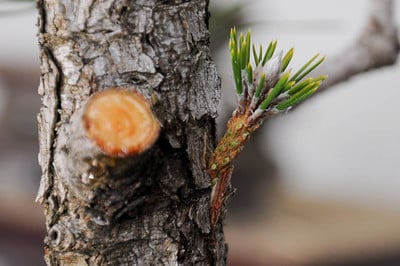
Scion sticking out too far
When the cut is made properly the scion fits snug.
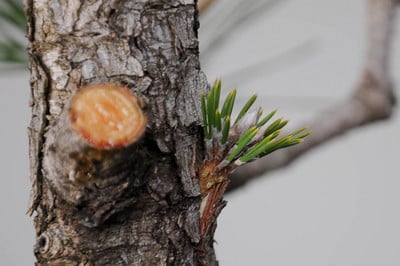
Scion inserted to proper depth
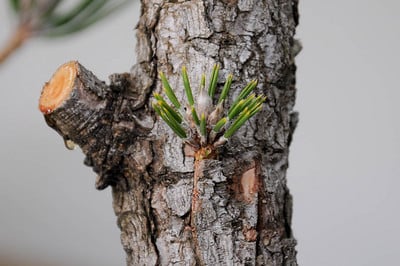
Scion inserted to proper depth- front view
Next I wrap the trunk with grafting tape. I make it snug but not overly tight. This keeps the scion in place.
I wish I knew of a better source for grafting tape. I’ve used a variety of materials, but the one I like best comes from a Home Depot-like store in Japan. I try to stock up when I get the chance.
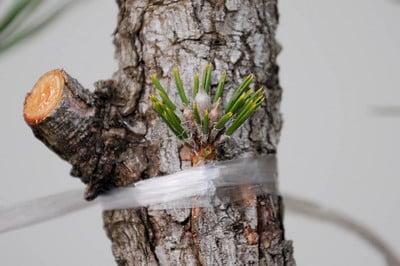
Grafting tape holding the scion in place.
The final step is covering the scion with a grafting bag that contains moist sphagnum moss. This provides extra humidity that prevents the scion from drying out before new vasculature can keep it alive.
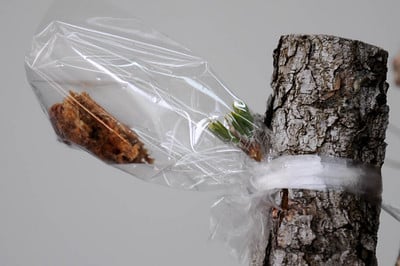
Graft completed
You may notice that the trunk is cut right above the graft. I don’t expect it to grow – if no sap flows past the graft it’s unlikely to succeed. I prepared this graft last so I could take my time and get pictures along the way. I’ve left it in place to see what happens – it will be fun to see if it works!
Subscribe to Bonsai Tonight
New Posts Delivered Every Tuesday and Friday
David says
Well explained and pictured. Tx!
I will try this next week on a collected scots pine. I hope with succes. After how long do you know if it succeeded or not?
Regards
David
xwires says
Hi David – I’ve seen scions remain green for almost a year before turning brown. Typically, if the bud opens in spring and the scion makes it through summer, then the graft is ok. That said, use caution when piercing, and later removing the grafting bag. I sometimes leave the grafting tape around a union until a second spurt of growth strengthens it the following year.
David says
It’s indeed a good idea to leave the bag a bit longer. I think i will also do that. Especially because the weather in belgium is not that great…
Michael M says
Very clear, Thanks. What about after care? I know with grafting to branches it helps to reduce and then eliminate growth further out on the branch, to “force” more water flow into the graft area. With grafting on the trunk do you reduce or eliminate branches above the graft to help redirect the sap flow? Do you ever shade the bagged graft to keep it from over heating or is it better in full sun?
Thanks
Michael
xwires says
Hi Michael – Good questions. Grafting after-care is a big topic about which I only know a bit. As I understand it, it’s a good idea to maintain some sap flow past a graft union but not too much or the tree will find little reason to put energy into the scion. I also shade the bags. I’ve tried covering the entire bag, covering just the top of the bag, leaving it uncovered, and keeping the entire tree under shade cloth. I think giving the scion some break from the full sun is important, and more important for conifers than for deciduous trees. I’ll post more specifics as I discover them.
Will Feldman says
Do you use a hammer to insert the chisel? Or can the chisel just be pushed into the trunk?
xwires says
Hi Will – I use a hammer. Although the bark is usually soft, the wood beneath is not. When hammering, I try to prevent the tree from moving around a lot in the pot to avoid damaging the roots.
sarita says
thanks for grafting tips along with illustration. is the rainy season, or huimid climate perfect for grafting pines.
xwires says
Sarita – I’ve had the best luck grafting pines when it’s cold out, towards the end of winter. While humidity is great for keeping the scions from drying out, it’s more important that the tree’s sap is flowing very slowly when the graft is made. When it’s warm out, during spring, summer and much of fall, the sap runs fast. If sap gets between the scion and the tree, it’s much harder for the graft to take. It’s for this reason that grafts are made quickly – to avoid letting the incision fill with sap before getting the scion into place.
bonsaijapan says
Hi Jonas.
I have not yet tried grafting bud to trunks like you have shown above but i can see the benefits. Just one quick question. Are you aligning the cambium at the top of the chisel cut?
When i have bud grafted branches i have made use of the exposed cambium along the length of the cut but it appears that with the above technique you only expose the cambium of the trunk at the top of the incision.
I hope to see updates on your success of these grafts.
thanks,
Joe
xwires says
Hi Joe – the goal is to get the cambium layers on scion and host to line up which means the scion’s cambium layer will line up a bit below the chisel cut. Depending on the thickness of the bark and the angle of the chisel, this may be just below the cut or further in. You’re right about getting the sides to line up – the more cambium that lines up, the better. Because there’s less exposed cambium on the host with this method, it’s naturally harder to get trunk grafts to take.
As expected, the graft made at the top of the trunk failed quickly – I’ll try to get better pics as I get ready to graft again next month.
bonsaijapan says
Thanks for that Jonas,
I have had some good success with branch grafting this season and look forward to trying to get some trunk grafts to work next season.
I will try to make a post on some of my observations soon.
Talk soon,
Joe.
Nuno Encarnação says
Hi!
First, let me congratulate you for the wonderful blog that you publish. I’ve learned a lot for all off your posts.
I belong to a local bonsai club here in Portugal and I’d like to ask for your permission to translate this post and use your images to ilustrate the process of grafting in pines, since some of our local members can´t read english.
Thank you and keep up the good work!
Nuno